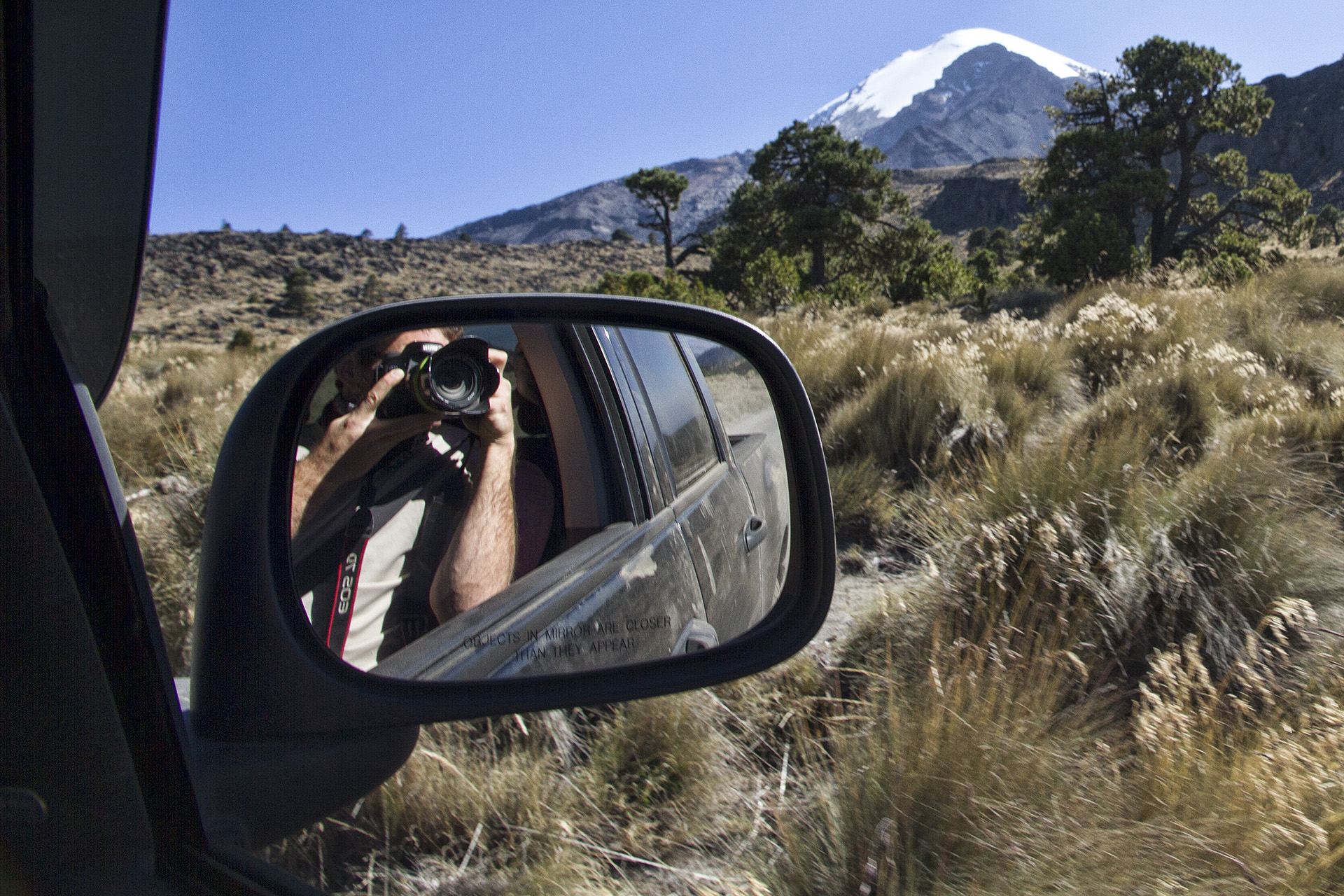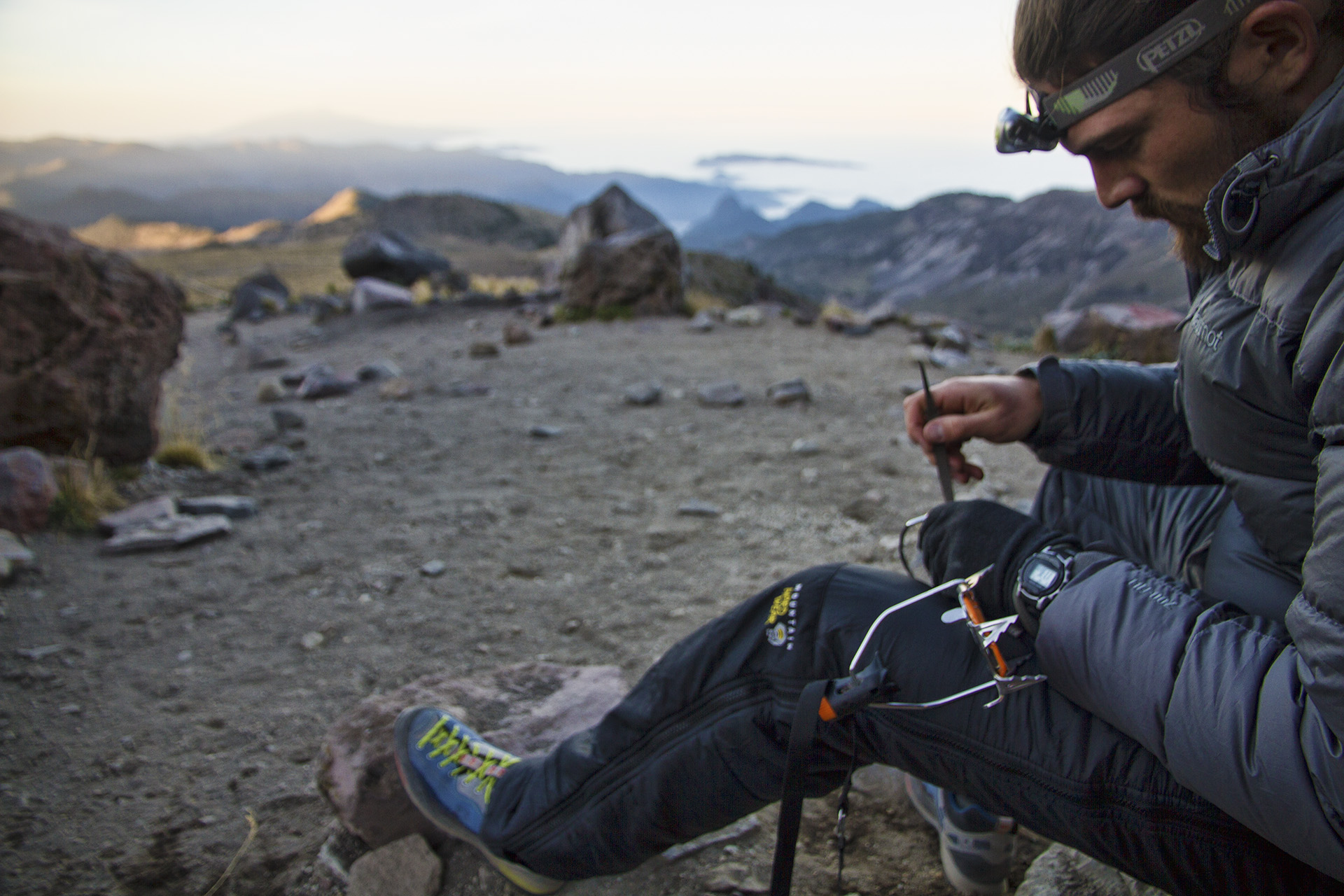In November 2015, my brother Jordan and I set off on a two week trip to climb the third highest peak in North America, Mexico's 5,636-meter / 18,491-foot Pico de Orizaba. Fortunate timing allowed us to also complete an ascent of Mexico's third highest peak, Iztaccihuatl (5,230 m / 17,159 feet). The expedition was self-supported. The following photo essay explores the journey through prose and picture, luring the reader into a tangible world of clammy Mexican metros, organ-shifting truck rides and lonely twilight glacier traverses.

After a mid-day arrival in smoggy Mexico City, we head directly toward the capital’s main bus station, intending to get on the first bus possible to Puebla, where we spend the night in a windowless hotel room. The next morning is spent wandering the streets of Puebla, half in an attempt to find fuel for our camp stove and half out of a curiosity for what the city looks like on a Sunday.



From Puebla, we huck our gear bags onto another bus going to Tlachichuca, a small village amongst the corn fields scattered across the plains surrounding the base of Pico de Orizaba. We are greeted by Doctor Reyes, a retired surgeon and ex-mountaineer who has transformed his family’s century-old soap and glycerine factory into a lodge catering to climbers.

Dr. Reyes’ lodge has impressive history and provides great views of our objective, Pico de Orizaba, as the sun dips toward the horizon.

To try to blend in as an ice-axe-wielding, six-foot gringo carrying two jugs of water and a roll of toilet paper through the center of a small Mexican mountain town is a fruitless endeavor. We venture out anyway. The morning is bright as the village recovers from a collective hangover. A quick jaunt across the central zócalo to a small store for last minute food supplies and 35 liters of water is all we have time for before Dr. Reyes’ driver shows up in his 4x4 to take us to the base camp hut, the Refugio Piedra Grande.

A quick assessment of the forecast reveals a front moving into the region in four days. After speaking with other climbers recently returned from the climb, we decide to forego the acclimatization hike that would have taken us up Sierra Negra, a subsidiary peak south of Pico de Orizaba. The night is spent organizing gear and making lists of supplies to buy in the morning.

Joel, our driver, asks us about our lives in the United States as he guides the bulky truck up the rutted back road, taking us from 9,000 feet a.s.l. to nearly 14,000 feet a.s.l. The routes on the glacier start to become apparent.

A final differential-crunching turn around a ridge and our home for the next 3 nights reveals itself. The three-story Piedra Grande hut sits humbly at the bottom of the scene before us, at 14,000 feet a.s.l. A faint trail can be seen running upward toward a prominent boulder field and area of glittering rockfall, aptly called the Labyrinth, where the main trail disappears into a thousand intertwined options. The route is capped by the north-facing Jamapa Glacier. The highest point in Mexico surveys us from its lofty perch at 18,491 feet above sea level.

A couple hundred feet away from the Piedra Grande hut, a small, yellow tin shed hut sits amongst the car-sized boulders. The small space inside the hut is just large enough for the both of us and our gear.

The afternoon is spent slowly wandering around the surrounding landscape. Climbers are still coming down from the summit. We converse with a few who give us insight into the conditions of the glacier. A couple battered SUVs wait around as the climbers, exhausted from their summit bids, clumsily pack their gear and pile into the vehicles.

Shadows stretch long and the day grows weary. The trickle of climbers stops and the last of the trucks disappear over the crest. Without the sun, the temperature drops quickly. Wind chills our faces and emptiness accompanies the shadows crawling over the camp. There is one Korean climber preparing his dinner in the main hut. At 3am I hear the unmistakable sound of footsteps on loose rock as he departs base camp. Suerte, compadre.

The next day is spent doing an acclimatization hike under beautiful blue skies and cirrus clouds to scope out the way through the Labyrinth.


Part way through the Labyrinth, we cross paths with the Korean. We had tracked his tiny figure from base camp as it progressed slowly across the upper parts of the glacier in the morning. He tells us the going was slow because the glacier is icy and steep near the summit. We congratulate him on his summit and part ways.


Reaching the glacier takes far less time than anticipated. We can see the summit. We feel fit and spirits are high. We decide to attempt the final push that night and leisurely head back down to the hut.

The evening is spent preparing gear for the summit push.

Night is restless. The effects of altitude set in and my thoughts dwell on the dull pain in my forehead. I have felt this before at altitude, but it is something that I must monitor. For hours I squirm in my sleeping bag, trying to find a comfortable position. The worn wooden door creaks endlessly on corroded hinges. I pass the time by watching mice scurry across the floor. Wind gusts lift parts of the sheet metal roof every so often and sets them back down with an unsettling thud. My alarm goes off at 2:30 am.

Faint starlight gives an eerie glow to the darkness during the approach. There are two small lights filtering through the Labyrinth above us during the night, but they are moving abnormally slow. We reach them as we top out. A Spaniard and his Mexican friend are attempting to reach the summit having only arrived late last night. The Spaniard is concerned about his friend, who slumps against a rock. Exhaustion and altitude have taken their toll. They will go no further.


Dawn breaks as we unstrap the crampons and ice axes from our packs. Low clouds sweep inland from the Gulf of Mexico only for their advance to be halted by the Cordillera Neovolcánica, on which we stand.



A glacier is an inherently lonely place, but its layers preserve the stories of days long gone. Each careful bite of crampons into its icy flank is a small wound that must be inflicted to ensure your story’s continuation.

18,000 feet is reached, then reluctantly left behind. Our pace has slowed dramatically as our muscles struggle to operate normally in the oxygen-deficient environment. My mind dwells on the warmth of people, places and moments of my past. These memories have a tendency to seep forth from some deep wellspring of my being when the world around me is open, empty and unforgiving.

Earlier in the year, a climbing party stumbled upon a mummified corpse on the same face of the glacier we are climbing. Further rescue parties revealed a second and third body, with speculations that these were the remains of climbers that had disappeared in a 1959 avalanche.


We are ripped away from our thoughts and the monotonous sound of crunching ice beneath our boots is broken by a terrifying roar from above. Instinctively, we whip our heads upwards and a feeling of dread defines the next several milliseconds of our lives. These are not avalanche conditions, we repeat to ourselves. The wave of sound becomes more defined and a plane crests over the near horizon.


The glacier ends some 50 feet below the summit and a short walk takes us to the lip of the immense crater. We are standing on the highest point in Mexico, the third highest peak in North America. Although thoughts of descending the icy slopes stews in the back of our minds, we are elated at reaching the top.



Congratulations are shared as the brief rest has been earned. Clouds begin to form, prompting us to begin our descent before the inevitable mid-day white out sets in. The descent is precarious, as patches of hidden water ice do their best to rid themselves of our presence.


In early afternoon we regain the edge of the glacier. The descent through the Labyrinth is uneventful, but soon the white out rolls in and we watch as a trio of scientists still on the glacier disappear into fast-moving clouds.

A hot meal and rest go a long way to restoring the spirit after spending time exerting oneself at altitude.

It hardly seems real to think that the climb is already over. Our dialogue with the mountain we have just interacted with for the past three days slowly comes to a close, but our alpine sixth-sense has picked up on something else. A mountain laying serenely in the distance begins to speak to us…





































